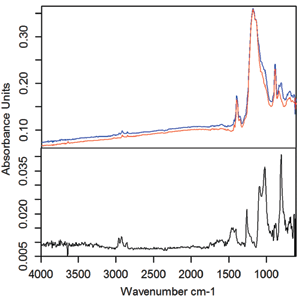Distinguishing Release Agents on Molded Rubber Using ATR Spectroscopy
Special Issues
Molded rubber products, like o-rings and gaskets, are typically coated with a release agent during manufacturing to facilitate the removal from the mold. Detecting the release agent is important for manufacturing since improper application can cause the o-rings to adhere unexpectedly to the mold.
Measuring the release agent on molded rubber products by infrared spectroscopy presents several challenges because the release agent layer is typically very thin and many base materials are carbon filled, and molded into small or unusual shapes. Thus, analysis requires a surface sampling technique with a relatively small sampling area, such as single-reflection ATR.
This applications note demonstrates the use of ATR to distinguish o-ring release agents from the underlying fluoroelastomer.
Experimental
A fluoroelastomer o-ring was investigated using the Harrick MVP-Pro in conjunction with a commercial FT-IR spectrometer. The MVP-Pro, shown in Figure 1, is a single reflection ATR accessory with a 45° incident angle and a 0.5 mm diameter sampling area on its Si crystal. All infrared spectra were collected with an 8 cm-1 resolution, averaged over 32 scans. Two spectra were recorded: one of the exterior of a black fluoropolyer (FKM) o-ring and another from the interior slice of the o-ring.

Figure 1: The Harrick MVP-Pro.
Results and Discussion
Figure 2 shows the ATR spectra of the FKM o-ring, including the outer surface, the inner substrate, and the resulting difference. The measured spectra show characteristics typical of a poly(aliphatic) fluoride, as expected. The strong similarity between the spectra indicates that the release agent coating the o-ring is extremely thin. Slight spectral differences can be seen around 1020 cm-1 and 800 cm-1. Subtracting the two spectra results in the spectrum shown in black, which is clearly identifiable as silicone oil. Silicones are one of the materials frequently used as a release agent.

Figure 2: ATR spectra of the o-ring: exterior (blue), interior (red) and subtraction result (black).
Conclusion
From the infrared spectra presented here, it is clear that the release agent can be distinguished from the bulk molded rubber using Si micro-ATR methods and the MVP-Pro.

Harrick Scientific Products, Inc.
141 Tompkins Ave., Box 277, Pleasantville, NY 10570
tel. (914) 747-7202, fax (914) 747-7409
Website: www.harricksci.com
